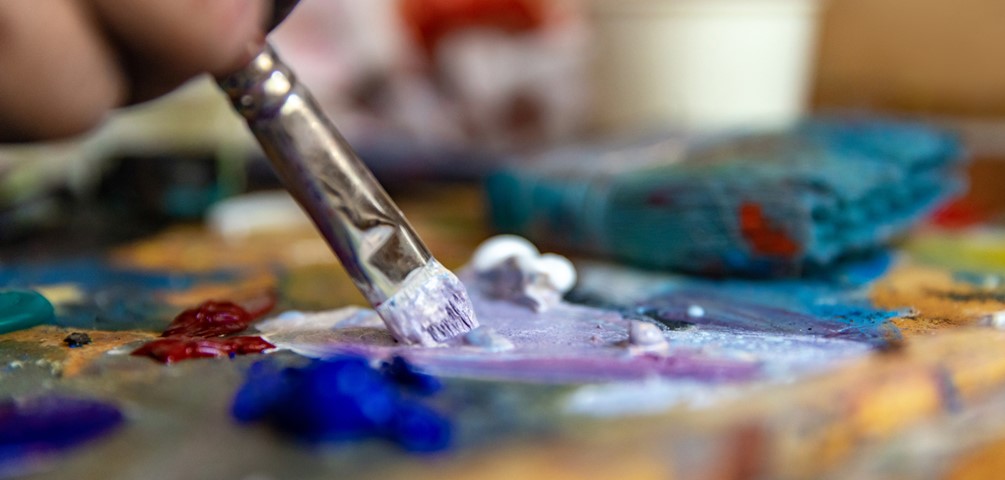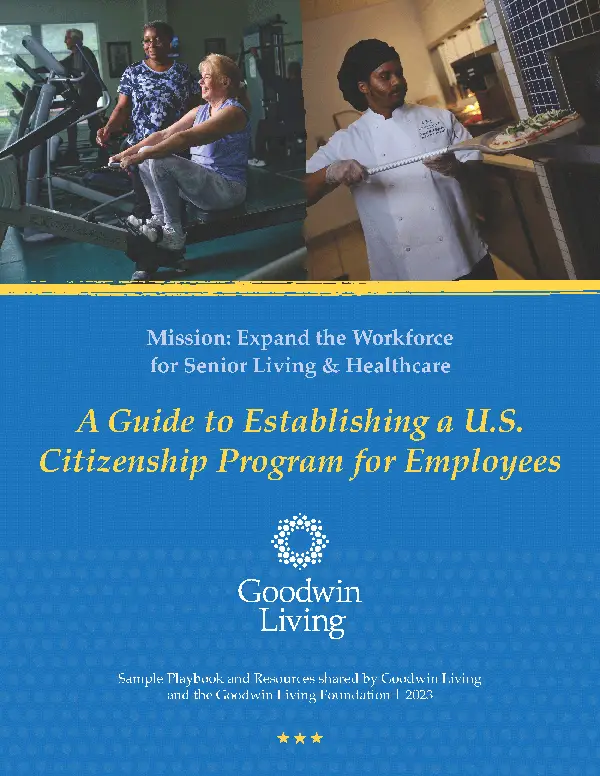
Live with Purpose - January 31, 2023
By Amanda Ranowsky
At Goodwin Living, art serves as a creative outlet for many residents. A dedicated art room and trained coordinator provide frequent opportunities for residents to develop their skills and pick up new hobbies.
Art also serves as a therapeutic tool that team members use to work with residents on goals such as self-expression, ability to stay on task, socialization, improving mood and working on fine motor skills. It can also be used to help residents who are exhibiting stress or anxious behaviors or with residents experiencing cognitive challenges such as Alzheimer’s or other forms of dementia.
In 2022, Goodwin House Bailey’s Crossroads (GHBC) received a grant from LeadingAge Virginia to fund facilitator training and supplies needed to begin an Opening Minds Through Art (OMA) program at GHBC. With a focus on helping those with dementia, the OMA program held great interest and potential.
“OMA is an internationally recognized art program that is helping heal the impact of loneliness and cognitive decline for thousands of older adults every day,” shared Karen Doyle, associate executive director of GHBC. “We will use this training to enhance our art program at GHBC and implement their techniques into programs for all levels of living.”
GHBC Creative Arts Coordinator Adrienne Wyman and Therapeutic Recreation Supervisor Michelle Weinstein became trained OMA facilitators in August 2022. In October of that year, they brought a pilot-version of the program to GHBC residents.
I spoke Michelle and Adrienne about their experience with the OMA program and its potential to improve the lives of older adults. The Q&A below reflects their collective answers.
We started with a six-week pilot in October 2022. A full-blown OMA program would usually include a team of young volunteers (college or high school-aged) who would come every week and partner with an “artist,” as OMA terms the person with dementia who is participating in the program. At the time, COVID restrictions made it difficult for us to welcome an outside group. Instead, we found younger team members who were willing to volunteer and paired them with six Health Care Center residents who are living with dementia or other cognitive impairments.
In the future, we hope to offer the program to residents in our Memory Support level of living. In the meantime, we’ve implemented many of the techniques that we learned from OMA into our existing art program for Memory Support residents, and now they really look forward to our art sessions.
The program is very structured. We demonstrate the project to the volunteers, and the volunteers then go meet up with their artist to work. We start by singing a song together to get everyone in a happy mood—usually it’s “You Are My Sunshine.” Then we hand out a bag of supplies to each pair and they work on the project together. Each week, we do a different project that has been carefully planned and tested by OMA.
As the volunteer is working with the artist, they’re careful not to do anything for them or tell them what to do. They ask the artist, “what do you want to do?”
We never offer more than two choices at a time. For example, we’ll have a plate with a cool palette of colors and a plate with a warm palette of colors and say, “do you want the warm color palette or the cool color palette?” It’s easier for someone with dementia to make choices like this as opposed to a more open-ended question like “what color paint do you want?”
When they finish their projects, we take each piece and show it to the other artists and ask what they think of it. They really compliment each other—we’ve never seen anyone not compliment someone—and you can see the artist’s self-esteem rise as they discover that they can do something that perhaps they didn’t think they could do.
We also make sure that every artist gives their piece a title—some of the titles they come up with are really great! Then we end the session with another song.
It gives them a sense of self-esteem to be able to create something. They’re all modern art projects, and they look professional. It’s a simple process with easy, step-by-step instructions, but it turns out looking like something that’s complicated. It’s age-appropriate and gives them a sense of pride because you’re treating them like adults instead of doing something that looks childish or babyish. We’ve had independent living residents see their projects and ask if they could do them, too!
At the start of each session, we have the artists fill out a survey to gauge where they are mood-wise as they begin their project. Then we survey again at the end. We’ve seen how doing the projects raises their mood and how that feeling is sustained throughout the day.
One artist in particular would say, every time we would invite her to join in, “I’m not an artist.” But when she got started with the project, she and her partner would work really well together. They really connected. And as we wrapped up each session, she would say, “Thank you so much for taking me to this! I’m so glad you brought me!” You could see that her mood was elevated and that she had brightened from doing the project.
The program creates a lot of different opportunities. There’s the opportunity for residents to interact with a younger generation, and the opportunity for those in the younger generation to gain empathy and understanding as they work with older adults. It’s also an opportunity for someone who has never felt like they are an artist or particularly creative to create something that they are proud of and can look back and say, “Wow, I did that.”
We’ve incorporated some OMA techniques into art programs in all levels of living at GHBC, including having residents name their project, putting projects in mats for presentation and using layering as an artistic technique. These techniques have been wonderful additions to our offerings.
In the coming months, we hope to expand the program by partnering with local high schools or universities to recruit volunteers to pair with residents, starting with residents in our Memory Support level.
_________
As Marketing & Communications Specialist, Amanda Ranowsky partners with colleagues throughout Goodwin Living to tell our stories and raise brand awareness. From printed collateral to digital marketing, Amanda covers many bases. Before joining Goodwin Living, Amanda worked for a small, family-owned business where she gained experience in content marketing. Amanda’s creative expression extends beyond the office. She is an active member of community theater and chorus groups.
